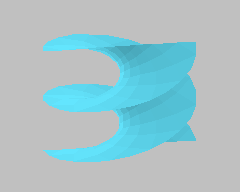

 |
This discrete minimal helicoid extends minimally to an infinite complete discrete surface whose coordinates are given by an explicit function. This model is an example of a family of discrete helicoids. All of these helicoids have a simple explicit description of their vertices.
We define discrete compact minimal surfaces as piecewise linear continuous compact triangulated surfaces that are critical for the area functional with respect to all variations through surfaces of the same type that preserve the simplicial structure and the boundary.
This model is an explicit representation for discrete helicoids (see [1] for a proof of the representation). These discrete helicoids are a natural second nontrivial example of complete embedded discrete minimal surfaces, after the discrete catenoids (see [5]).
There exists a 4-parameter family of complete embedded discrete minimal helicoids, with the connectivity as shown in the picture. The vertices, indexed by integers i and j, are the points
x = (r Sinh(x0 + j delta)/Sin(theta)) Cos(i theta)
y = (r Sinh(x0 + j delta)/Sin(theta)) Sin(i theta)
z = i r
where the parameters are
These surfaces are invariant under the screw motion that combines vertical upward translation of distance 2 r with rotation about the z-axis by an angle of 2 theta. All helicoids of this family interpolate smooth helicoids since the horizontal vertices lie on straight lines and the vertical twist and distance of adjacent lines are constant.
The helicoids are comprised of planar quadrilaterals, each triangulated by four coplanar triangles. Each quadrilateral is the vertex star of a unique vertex whose position within the quadrilateral may be arbitrarily choosen. In this model the position of this vertex was choosen to avoid a case distinction in the formula. None of its four boundary edges of the quadrilateral are vertical or horizontal, and one pair of opposite vertices in its boundary have the same z-coordinate, and the four boundary edges consist of two pairs of adjacent edges so that within each pair the adjacent edges are of equal length.
Note, the helicoids are not directly discrete conjugates of the discrete catenoids [5] since the discrete conjugate surfaces of a conforming triangulation is a non-conforming triangulation as described in [6].
Model produced with: JavaView 2.04.001
| Keywords | Minimal Surface; Discrete Surface; Helicoid | |
| MSC-2000 Classification | 53-04 (53-XX, 68Uxx, 68Rxx, 65Kxx, 65M50) | |
| Zentralblatt No. | 01683035 |
Submitted: Mon Jan 22 09:21:14 CET 2001.
Revised: Thu Aug 30 14:51:35 CET 2001, Mon Aug 27 21:23:20 CET 2001.
Accepted: Tue Sep 11 15:20:29 CET 2001.
Technische Universität BerlinWayne Rossman
Fachbereich Mathematik
Straße des 17. Juni 136
10623 Berlin
Germany
polthier@math.tu-berlin.de
http://www-sfb288.math.tu-berlin.de/~konrad
Kobe University
Mathematics Department
Faculty of Science
Rokko, Kobe 657-8501
Japan
wayne@math.kobe-u.ac.jp
http://www.math.kobe-u.ac.jp/HOME/wayne/wayne.html